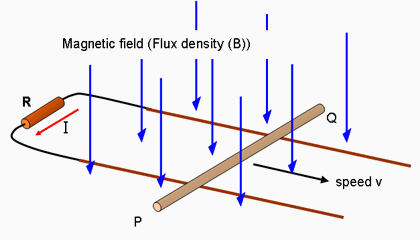In the situation with the bar moving on wire rails, when we describe the situation in the frame of the rails, electric field of substantial magnitude is present only in and near the resistor. In the wires and in the rod, electric field is negligible, since they are very good conductors.
If you're wondering how are the charge carriers forced to move in the bar without electric field in it, the answer is, they are forced to do so by the joined action of the magnetic forces and forces of constraint that keep the carriersinside the wires. Magnetic force deflects the carriers trajectories, they impact on the bar walls (or lattice of nuclei forming the bar) and since they cannot get out of the bar, the bar acts back and accelerates the carriers which leads to electric current. The forces of constraint acting on the charge carriers are believed in principle to be also of electromagnetic nature, but they are very localized so macroscopic electric field will not be measurable near the bar. Magnitude of emf for the circuit
$$
|emf| = qvBL
$$
can be expressed as
$$
|emf| = |d\Phi/dt|
$$
where $\Phi$ is magnetic flux through the circuit.
What your teacher is talking about when he says "remove the circuit" is an entirely different physical situation, where the bar is not present at all, or is at rest. Then, if the magnetic field itself is made to change (for example, the magnet is made to approach the bar) in time, then there will be vortex-like electric field everywhere including the bar and the space around it. Then, if we calculate work of this electric field per unit charge along the path $s$ where the circuit was, we can express it as $d\Phi/dt$:
$$
\left | \int \mathbf E \cdot d\mathbf s \right | = \left| \frac{d\Phi}{dt}\right|.
$$
Now, if there was a wire where the path $s$ goes, this would result in emf that has the same value.
As you can see, the two situations are different and the quantity calculated is also of different kind. The common point your teacher was talking about is the result that whether the magnetic flux changes by change of geometry or change of magnetic field, in both cases the emf is given by rate of change of magnetic flux. But the mechanism of how this happens is entirely different.

